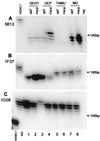Extensive polymorphism in Cryptosporidium parvum identified by multilocus microsatellite analysis
- PMID: 10919789
- PMCID: PMC92153
- DOI: 10.1128/AEM.66.8.3344-3349.2000
Extensive polymorphism in Cryptosporidium parvum identified by multilocus microsatellite analysis
Abstract
Restriction fragment length polymorphism and DNA sequence analysis discern two main types of Cryptosporidium parvum. We present a survey of length polymorphism at several microsatellite loci for type 1 and type 2 isolates. A total of 14 microsatellite loci were identified from C. parvum DNA sequences deposited in public databases. All repeats were mono-, di-, and trinucleotide repeats of A, AT, and AAT, reflecting the high AT content of the C. parvum genome. Several of these loci showed significant length polymorphism, with as many as seven alleles identified for a single locus. Differences between alleles ranged from 1 to 27 bp. Karyotype analysis using probes flanking three microsatellites localized each marker to an individual chromosomal band, suggesting that these markers are single copy. In a sample of 19 isolates for which at least three microsatellites were typed, a majority of isolates displayed a unique multilocus fingerprint. Microsatellite analysis of isolates passaged between different host species identified genotypic changes consistent with changes in parasite populations.
Figures



References
-
- Aiello A E, Xiao L, Limor J R, Liu C, Abrahamsen M S, Lal A A. Microsatellite analysis of the human and bovine genotypes of Cryptosporidium parvum. J Eukaryot Microbiol. 1999;46:46S–47S. - PubMed
-
- Awad-El-Kariem F M, Robinson H A, Petry F, McDonald V, Evans D, Casemore D. Differentiation between human and animal isolates of Cryptosporidium parvum using molecular and biological markers. Parasitol Res. 1998;84:297–301. - PubMed
-
- Cacciò S, Homan W, van Dijk K, Pozio E. Genetic polymorphism at the β-tubulin locus among human and animal isolates of Cryptosporidium parvum. FEMS Microbiol Lett. 1999;170:173–179. - PubMed
-
- Cacciò S, Homan W, Camilli R, Traldi G, Koterbeek T, Pozio E. A microsatellite marker reveals population heterogeneity within human and animal genotypes of Cryptosporidium parvum. Parasitology. 2000;120:237–244. - PubMed
Publication types
MeSH terms
Substances
LinkOut - more resources
Full Text Sources
Medical
Research Materials
Miscellaneous

